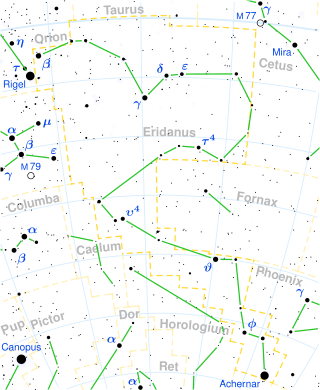Tau4 Eridani
 A star chart of the Eridanus constellation showing the star, annotated. Asterism somewhat unusually drawn to curve around into Cetus (specifically Pi Ceti), but which features in the Celestial Meadows of Chinese constellations, from Gamma eastwards and south, through to the end of the nine Tau numbered stars. | |
| Observation data Epoch J2000.0 Equinox J2000.0 (ICRS) | |
|---|---|
| Constellation | Eridanus |
| Right ascension | 03h 19m 31.00224s[1] |
| Declination | −21° 45′ 28.3049″[1] |
| Apparent magnitude (V) | 3.65[2] |
| Characteristics | |
| Evolutionary stage | asymptotic giant branch[3] |
| Spectral type | M3/4 III[4] |
| U−B color index | +1.79[2] |
| B−V color index | +1.61[2] |
| Variable type | Lb[5] |
| Astrometry | |
| Radial velocity (Rv) | +41.7±0.7[6] km/s |
| Proper motion (μ) | RA: +51.89[1] mas/yr Dec.: +32.92[1] mas/yr |
| Parallax (π) | 10.71 ± 0.54 mas[1] |
| Distance | 300 ± 20 ly (93 ± 5 pc) |
| Absolute magnitude (MV) | −0.79[7] |
| Details | |
| Mass | 1.8±0.3[8] M☉ |
| Radius | 106[9] R☉ |
| Luminosity | 1,537[10] L☉ |
| Temperature | 3,712[8] K |
| Other designations | |
| Database references | |
| SIMBAD | data |
Tau4 Eridani (τ4 Eridani, τ4 Eri) is a binary star system in the constellation Eridanus. It is visible to the naked eye with an apparent visual magnitude of 3.65.[2] The distance to this star can be estimated using the parallax method, which yields a value of roughly 300 light years.[1]
This is an evolved red giant star currently on the asymptotic giant branch[3] with a stellar classification of M3/4 III.[4] It is a slow irregular variable star of type Lb, undergoing changes in magnitude over the range 3.57−3.72[5] with a periodicity of 23.8 d.[12] The measured angular diameter of Tau4 Eridani is 10.58±1.00 mas.[13] At its estimated distance, this yields a physical size of about 106 times the radius of the Sun.[9] It shines with 1,537[10] times the luminosity of the Sun from an outer atmosphere at an effective temperature of 3,712 K.[8]
This is most likely a binary star system.[14] The companion is a magnitude 9.5 star at an angular separation of 5.7″ along a position angle of 291°, as of 2013.[15]
References
- ^ a b c d e f van Leeuwen, F. (2007), "Validation of the new Hipparcos reduction", Astronomy and Astrophysics, 474 (2): 653–664, arXiv:0708.1752, Bibcode:2007A&A...474..653V, doi:10.1051/0004-6361:20078357, S2CID 18759600.
- ^ a b c d Mermilliod, J.-C. (1986), "Compilation of Eggen's UBV data, transformed to UBV (unpublished)", Catalogue of Eggen's UBV Data, SIMBAD, Bibcode:1986EgUBV........0M.
- ^ a b Lebzelter, T.; Hron, J. (January 2008), "BRITE stars on the AGB" (PDF), Communications in Asteroseismology, 152: 178–181, Bibcode:2008CoAst.152..178L, doi:10.1553/cia152s178.
- ^ a b Houk, N.; Smith-Moore, M. (1988), Michigan Catalogue of Two-dimensional Spectral Types for the HD Stars, vol. 4, Bibcode:1988mcts.book.....H.
- ^ a b Ruban, E. V.; et al. (September 2006), "Spectrophotometric observations of variable stars", Astronomy Letters, 32 (9): 604–607, Bibcode:2006AstL...32..604R, doi:10.1134/S1063773706090052, S2CID 121747360.
- ^ Gontcharov, G. A. (November 2006), "Pulkovo Compilation of Radial Velocities for 35 495 Hipparcos stars in a common system", Astronomy Letters, 32 (11): 759–771, arXiv:1606.08053, Bibcode:2006AstL...32..759G, doi:10.1134/S1063773706110065, S2CID 119231169.
- ^ Cardini, D. (January 2005), "Mg II chromospheric radiative loss rates in cool active and quiet stars", Astronomy and Astrophysics, 430: 303–311, arXiv:astro-ph/0409683, Bibcode:2005A&A...430..303C, doi:10.1051/0004-6361:20041440, S2CID 12136256.
- ^ a b c Halabi, Ghina M.; Eid, Mounib El (2015). "Exploring masses and CNO surface abundances of red giant stars". Monthly Notices of the Royal Astronomical Society. 451 (3): 2957. arXiv:1507.01517. Bibcode:2015MNRAS.451.2957H. doi:10.1093/mnras/stv1141. S2CID 118707332.
{{cite journal}}: CS1 maint: unflagged free DOI (link) - ^ a b Lang, Kenneth R. (2006), Astrophysical formulae, Astronomy and astrophysics library, vol. 1 (3 ed.), Birkhäuser, ISBN 3-540-29692-1. The radius (R*) is given by:
- ^ a b McDonald, I.; et al. (2012), "Fundamental Parameters and Infrared Excesses of Hipparcos Stars", Monthly Notices of the Royal Astronomical Society, 427 (1): 343–57, arXiv:1208.2037, Bibcode:2012MNRAS.427..343M, doi:10.1111/j.1365-2966.2012.21873.x, S2CID 118665352.
{{citation}}: CS1 maint: unflagged free DOI (link) - ^ "tau04 Eri". SIMBAD. Centre de données astronomiques de Strasbourg. Retrieved 2016-10-13.
{{cite web}}: CS1 maint: postscript (link) - ^ Tabur, V.; et al. (December 2009), "Long-term photometry and periods for 261 nearby pulsating M giants", Monthly Notices of the Royal Astronomical Society, 400 (4): 1945–1961, arXiv:0908.3228, Bibcode:2009MNRAS.400.1945T, doi:10.1111/j.1365-2966.2009.15588.x, S2CID 15358380.
{{citation}}: CS1 maint: unflagged free DOI (link) - ^ Richichi, A.; Percheron, I. (May 2005), "First results from the ESO VLTI calibrators program", Astronomy and Astrophysics, 434 (3): 1201–1209, arXiv:astro-ph/0501532, Bibcode:2005A&A...434.1201R, doi:10.1051/0004-6361:20042257, S2CID 2847613.
- ^ Eggleton, P. P.; Tokovinin, A. A. (September 2008), "A catalogue of multiplicity among bright stellar systems", Monthly Notices of the Royal Astronomical Society, 389 (2): 869–879, arXiv:0806.2878, Bibcode:2008MNRAS.389..869E, doi:10.1111/j.1365-2966.2008.13596.x, S2CID 14878976.
{{citation}}: CS1 maint: unflagged free DOI (link) - ^ Mason, B. D.; et al. (2014), "The Washington Visual Double Star Catalog", The Astronomical Journal, 122 (6): 3466–3471, Bibcode:2001AJ....122.3466M, doi:10.1086/323920, retrieved 2015-07-22

